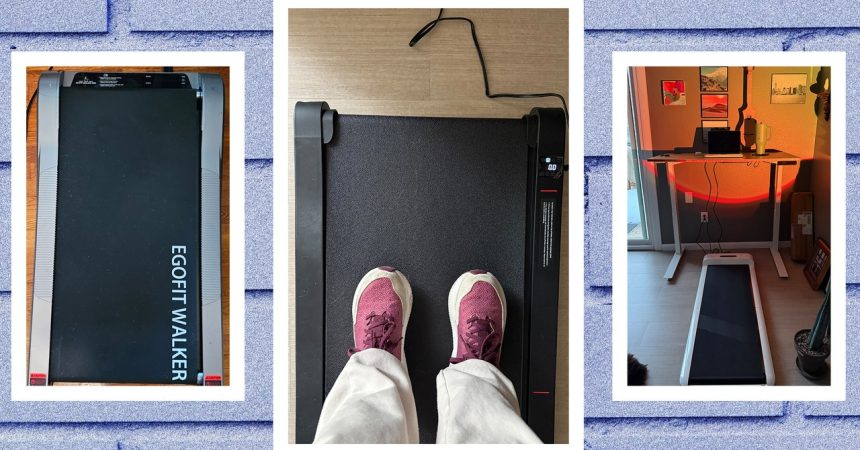The sedentary nature of desk jobs poses significant risks to both physical and mental well-being, contributing to a decline in overall health and productivity. Walking pads offer a compelling solution to this pervasive problem, enabling users to integrate physical activity into their workday without sacrificing work efficiency. These compact treadmills, designed to fit under standing desks, allow individuals to accumulate steps and engage in low-impact exercise while simultaneously attending to their professional responsibilities. The benefits extend beyond mere physical activity; the increased blood flow and mild exertion can boost energy levels, enhance focus, and improve overall mood, leading to greater productivity and a more positive work experience. The integration of walking pads into the workspace represents a paradigm shift in the approach to office wellness, promoting a more active and healthier lifestyle for desk-bound professionals.
The market offers a wide array of walking pads, each with its own set of features, capabilities, and price points. Selecting the right walking pad requires careful consideration of several key factors. Budgetary constraints naturally play a significant role, but equally important are space limitations within the home office environment. The footprint of the walking pad must be compatible with the available space, and foldable options are often preferred for their convenient storage. Weight capacity is another critical consideration; unlike robust running treadmills, walking pads have lower weight limits and are susceptible to wear and tear. Choosing a model with a higher weight capacity not only accommodates a wider range of users but also potentially extends the lifespan of the device.
Tracking metrics is a desirable feature for many users. While most walking pads display basic metrics like steps and mileage, the ability to sync this data with a smartphone app for comprehensive tracking and analysis is a significant advantage. For those who prioritize data-driven fitness, a walking pad with seamless app integration is highly recommended. Alternatively, a separate fitness tracker can be used to supplement the basic tracking capabilities of the walking pad.
Beyond the core functionalities, walking pads offer a variety of additional features that cater to specific user needs and preferences. Some models incorporate incline options, extending the range of exercise possibilities. Others boast speed ranges suitable for running, effectively transforming the walking pad into a compact treadmill. Integrated desks further enhance convenience, creating a fully functional workstation that seamlessly combines work and exercise. Remote controls and automatic speed adjustment features offer greater control over the walking experience. The ideal walking pad is one that aligns with the user’s intended usage and provides the features that best support their fitness goals and work style.
One highly recommended walking pad stands out for its combination of affordability, functionality, and user-friendly design. This particular model has garnered positive reviews, particularly within online communities, for its lightweight construction, ease of setup, and comfortable walking deck. Its robust weight capacity, exceeding that of many comparable models, contributes to its durability and longevity. The seamless remote connectivity and intuitive app integration further enhance its appeal. The setup process is remarkably simple, requiring minimal assembly time. While it includes a vibration mode of uncertain utility, the core features of this walking pad are undeniably compelling. Its compact size allows for easy storage, and its relatively short length poses no significant impediment to comfortable walking, even for individuals of moderate height. Overall, this walking pad offers an excellent balance of performance, convenience, and affordability.
Choosing a walking pad involves navigating a complex landscape of features, specifications, and price points. A thorough understanding of individual needs and priorities is essential to making an informed decision. Space constraints, weight capacity, metric tracking capabilities, and additional features like incline, speed range, and integrated desks should all be carefully considered. Prioritizing durability is also paramount, given the tendency of walking pads to experience wear and tear over time. Ultimately, the best walking pad is the one that best aligns with the user’s individual requirements, providing a seamless and effective way to incorporate physical activity into their daily routine while maximizing productivity and overall well-being.
The rise of the walking pad reflects a growing awareness of the detrimental effects of prolonged sitting and a proactive approach to integrating physical activity into the modern workday. These innovative devices offer a practical and accessible solution for individuals seeking to combat the negative consequences of sedentary lifestyles. By enabling users to walk while they work, walking pads empower them to prioritize their health and well-being without sacrificing productivity. The integration of walking pads into the workspace represents a significant step towards a healthier and more dynamic work environment, promoting a culture of wellness and enhancing the overall quality of life for desk-bound professionals. As the demand for healthier work habits continues to grow, walking pads are poised to become an increasingly integral part of the modern office landscape.



